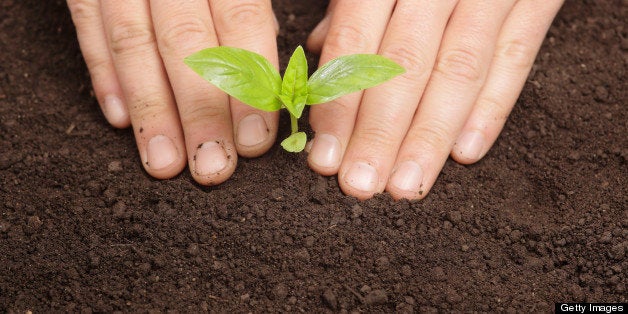

By Kelsey Johnson
Physical and Environmental science teacher, George Washington High School, Philadelphia, Pennsylvania.
The green sprig sits atop the orange slice with your omelet. Do you eat it? Many people disregard the parsley that beautifies their home fries or the mint that garnishes their oatmeal. Grandma Johnson, my 96-year-old role model, has taught me that parsley serves as a nutritious breath-freshener to be eaten after a meal. She is so fond of parsley that she brought a one-gallon freezer bag of fresh parsley on our road trip as a snack. Beyond a healthy morsel for the elderly, parsley might be the ticket for a new generation of healthy eaters and a cleaner environment.
Like most teachers, I avidly search for simple and inexpensive ways to bring content to life using real and relevant applications. I've field tested the CarbonTIME curriculum (to be released on the National Geographic Website this year), and designed projects where students plant seedlings in the classroom and transplant them to an outdoor garden. This year, however, I don't have the gusto to try gardening in our courtyard again. A smaller-scale version is necessary and parsley might be the saving grace.
As their culminating project, my environmental science students have designed an Earth Day fundraiser of made-to-order herb gardens that we sowed indoors. Students worked in teams to research about how herbs contribute to solving complex problems such as childhood obesity and global warming. For example, students elected to either (1) research how to incorporate herbs into everyday foods to make a guide to using herbs to cook more nutritious and delicious meals, (2) calculate the environmental benefit of growing your own garden and the impacts on the global carbon cycle, or (3) investigate access to fresh produce in their neighborhoods and synthesize information about local urban farms and farmers markets into an annotated city map. Each group produced either a flier or a public service announcement to present their results, and all final works will be published on our school's online newspaper.
Imagine chives, basil, cilantro, sage... each conjures a specific reaction or flavor, and herbs speak to multi-disciplinary interests. They distinguish regular food from gourmet; they make food -- even vegetables -- taste great. Herbs also provide a literal and metaphorical link between the health of an individual and the ecosystem.
Here's how it works. Plants use carbon dioxide (CO2), an important greenhouse gas, to produce the biomass that feeds us (and them!). Plants construct organic molecules -- food -- using invisible building blocks of CO2 gas, thereby removing a problematic greenhouse gas from the atmosphere. The carbon dioxide concentration of Earth's atmosphere is increasing in large part due to human combustion of fossil fuels. More plants growing means more carbon is tied up in organic molecules, and more CO2 is pumped out of the atmosphere and into the biosphere (living sphere).
Although the amount of CO2 stored in herbs is miniscule, it provides a useful, concrete framework for students to conceptualize the carbon cycle, and it might inspire them to grow a more sizable plot of biomass. Nature has a course of her own, and there is great value in advancing with baby steps. So next time you are about to leave that green sprig untouched on your plate, think again. Grandma just might know best.
Kelsey Johnson is a physical and environmental science teacher at George Washington High School in Philadelphia, Pennsylvania and a KSTF Teaching Fellow.